Note: In 2020, I’m writing 52 blog posts, one per week, released on Mondays or so. This is Week 20’s post. It continues last week’s Part 1 post about whistleblower Dr. Bright’s testimony.
Note: When in Texas I first began doubting the political party duopoly in the United States, the best argument against leaving the mainstream corporate culture seemed former British prime minister Margaret Thatcher’s: “There is no alternative” to biz, lesser evilism, etc. Since then, I’ve found and learned to see many good things too often drowned out by the volume of the duopoly and corporations. If you search my website, twitter, or just ask me (email dal@riseup.net or comment on my blog), I can point you to plenty of prosocial projects to participate in. Soon I’ll write a blog post listing projects I recommend organized by subject matter, etc.
Note: Regarding this post, yes I know conventional science/medicine, like alternative science/medicine, often leaves a lot to be desired to say the least, but I unfortunately don’t have time to get into that part of things in this particular post. If you want material on that topic, please see these by others, for starters: 1, 2, 3, 4, 5, 6, 7.
“It is not your fault, I know, but of those who put it in your head that you are exaggerating and even this testimony may seem just an exaggeration for those who are far from the epidemic, but please, listen to us” — intensive care physician Dr. Daniele Macchini, in translation from Humanitas Gavazzeni hospital in Bergamo, Italy, Friday 6 March 2020. (Additional attribution information.)
Same day as Dr. Daniele Macchini’s testimony from Italy, “Q: Mr. President, you were shaking a lot of hands today, taking a lot of posed pictures. Are you protecting yourself at all? How are you — how are you staying away from germs? THE PRESIDENT: Not at all. No, not at all. Not at all. […] Q: Have you considered not having campaign rallies? THE PRESIDENT: No, I haven’t. […] Q: Isn’t it a risk if there’s that many people close together? THE PRESIDENT: It doesn’t bother me at all and it doesn’t bother them at all.” Transcript provided by White House of Friday 6 March 2020 remarks by Donald Trump after tour of the Centers for Disease Control and Prevention in Atlanta Georgia.
A week prior at a rally, Trump said: “[T]he Democrats are politicizing the coronavirus. You know that, right? Coronavirus. They’re politicizing it. We did one of the great jobs [… The Democrats] have no clue, they don’t have any clue. […] this [disagreeing with him regarding coronavirus] is their new hoax.” Transcript of Trump rally Friday 28 February 2020 in North Charleston, South Carolina. I aim to help replace the Democratic Party and the Republican Party with prosocial self-governance (representative governance is by definition not self-governance); the point is, Trump called disagreeing with him on coronavirus creating a hoax.
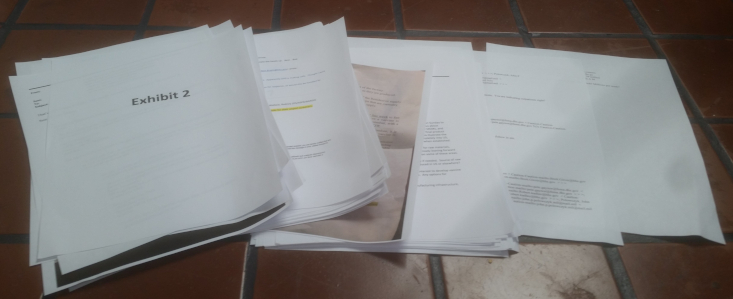
Following my post last week providing an overview of Dr. Rick Bright’s background and whistleblower complaint, as well as the wider context of the COVID-19 pandemic in the United States, I’d planned to dig into his complaint to give you a rundown of it. Then in his testimony to Congress on 14 May 2020, he discussed the evidentiary exhibits he submitted along with his complaint. Finding those (some pictured above) turned out more time consuming and interesting than I anticipated. This quick post explains what’s up with his missing exhibits and what we can do about it.
Bibliography versus secrecy
Dr. Bright submitted his whistleblower complaint to the federal Office of Special Counsel on 5 May 2020, along with an unknown number of evidentiary exhibits. In case you’re not familiar, in law an exhibit is basically physical or documentary evidence; in this case, it’s evidence, such as emails, substantiating what he says in the complaint. The law firm representing Dr. Bright publicized his whistleblower complaint, with redactions and no exhibits; I mirrored that file here. On the same day Dr. Bright filed his complaint, the Washington Post‘s Yasmeen Abutaleb (Twitter; yasmeen.abutaleb@washpost.com ) and Laurie McGinley (Twitter; laurie.mcginley@washpost.com ) wrote about it, and linked a document WaPo published containing 27 of his exhibits. The Washington Post exhibits document (which I mirrored here) stops after Exhibit 60. That means, assuming Dr. Bright used a typical sequential numbering scheme and stopped after Exhibit 60, that 33 exhibits are missing, blocked from our view. So where are they?
Step one to finding the blocked exhibits: get organized. On 18 May 2020, I made a list showing which exhibits of his are missing from and which are included in the Washington Post exhibits document. The two journalists bylined on the Washington Post article haven’t replied to my tweets or emails seeking any additional information or clarification, but like politicians, ‘verified’ blue checkmark journalists often respond to volume, so you can contact them too; that’s why their contact info is in the above paragraph. Here’s a screenshot of my list to give you an idea what I’m yammering about.
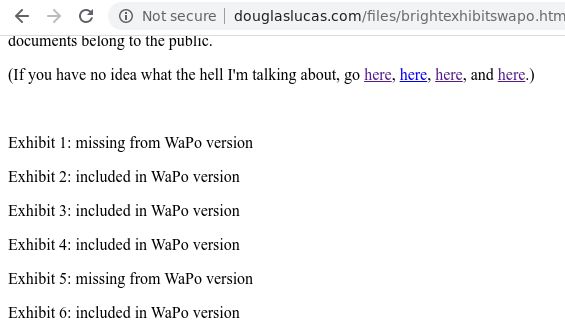
In Dr. Bright’s testimony to the federal House energy and commerce subcommittee on health (C-SPAN transcript; Rev.com transcript), he explained that he / his lawyer didn’t give some of his exhibits to the Congressmembers (i.e., he / his lawyer gave them only to the Office of Special Counsel), due to privacy and legal concerns. But Representative Anna G. Eshoo (D-CA), chairing the hearing, asked him: “Would you be willing to share the other exhibits once you remove personally identifiable information?” He said “Yes.” Except, whether that means to Congressmembers or to the rest of us—the documents rightfully belong to the public—remains unclear, unless of course we demand or take them (see below).
Via MuckRock, I today submitted a public records request to the Office of Special Counsel for all the exhibits.
To recap: Dr. Bright’s whistleblower complaint is accompanied by exhibits, probably a total of 60. The Washington Post published some of them (less than half, 27). Where are the rest (more than half, 33)? Dr. Bright told Rep. Eshoo he’d make them available. But make them available to Congress — or to us?
Task suggestions
If you’d like to help find the exhibits, our records we’re so far wrongfully barred from seeing, below are some task suggestions toward that goal. Remember, science-y studies and common sense repeatedly demonstrate that (informed) action feels better than anxiety.
- Ask the Washington Post journalists Yasmeen Abutaleb (Twitter; yasmeen.abutaleb@washpost.com ) and Laurie McGinley (Twitter; laurie.mcginley@washpost.com ) about the full set of exhibits. Where are they, do they have them, give them to us, why not, do it now! etc.
- Ask Rep. Anna G. Eshoo (D-CA) the same thing. Here’s her official contact info. Works better if you’re in her district, the 18th Congressional district of California, and/or if you throw money in her general direction, but neither is required to pick up a phone or keyboard.
- Ask Dr. Rick Bright on Twitter the same thing. Look, I’m grateful for his whistleblowing too, but if in his testimony to the federal Congress he meant just giving the exhibits to them—and if so, they were speaking as if we don’t exist—I don’t appreciate that and neither should you, since we’re the victims here.
- File open records requests for the exhibits. You can use MuckRock or submit them the old fashioned way. I hit up the Office of Special Counsel already but the more the better the odds they’ll hand the docs over. Somebody should try the relevant Congresspersons and subcommittee(s) too.
- Stop asking and just take the fucking things, while trying not to get arrested in the process. (Example.)
Garnet yams + tempeh + broccoli, steamed
That’s it until next week. When today I wasn’t writing this post, talking with friends/family, pitching an article, and listening to music, I was cooking. Below, pics of what I made. The seasonings are celtic salt, black pepper, dill weed, garlic powder, sesame seeds, and lemon juice. Be sure to get your tempeh in a glutenfree variety, and then this meal will be vegan and gluten free.


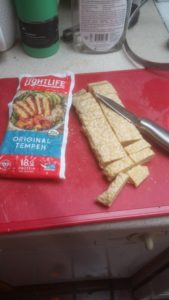
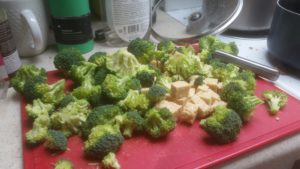
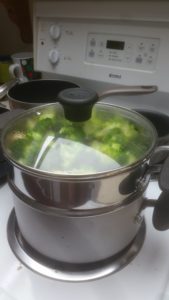




This blog post, Whistleblower Dr. Rick Bright’s testimony, part 1.5 of 4, by Douglas Lucas, is licensed under a Creative Commons Attribution-NonCommercial-ShareAlike 4.0 International License (human-readable summary of license). The license is based on a work at this URL: https://douglaslucas.com/blog/2020/05/20/rick-bright-whistleblower-testimony-part15. You can view the full license (the legal code aka the legalese) here. For learning more about Creative Commons, I suggest this article and the Creative Commons Frequently Asked Questions. Seeking permissions beyond the scope of this license, or want to correspond with me about this post otherwise? Please email me: dal@riseup.net.
 Twitter:
Twitter:
0 comments ↓
There are no comments yet...Kick things off by filling out the form below.
Leave a Comment